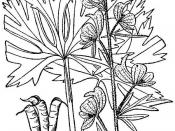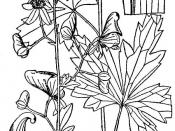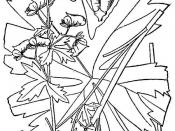Monkshood is a name of an endangered, beautiful, but extremely dangerous plant. It belongs to the Buttercup Family (Ranunculaceae). This plant is also known as Blue Rocket, Friar's hat, Helmet flower, Mouse bane, wolf bane, etc. Its scientific name is Aconitum napellus. It comes from a Greek term "En Akonias" which means, "growing on bare rocks". Most of this plant's names are derived from the extraordinary shape of this plant's large flower. They are usually of deep-blue, blue purple or sometimes even blue mauve and are about 1 inch in length. . The seed needs moist storage at 41 degrees for six weeks to overcome dormancy. This plant reproduces through seeds and tubers with a germination period of twenty days. The plant is totally dependent upon bees for fertilization. The flowers are pollinated when bumblebees pry open the blossom to collect nectar and pollen It takes nearly about three to four years for its hood shaped flower to bloom.
Monkshood is an erect, slender leafy plant. Its leaves are toothed and deeply lobed. The upper two petals of its flower are concealed and the lower three are either small or not present. Their deep blue helmet shaped flowers is arranged in long terminal spikes on stems and grow singularly. Their stems range from about 1 to 4 feet in length.
Monkshood is found on shallow or partially shaded cliff, and is also found at high elevation headwater. These plants also need moist, humus rich soil. In cooler climate Monkshood can grow in full sun, but they need a lot of water. Monkshood sites are often associated with cold air drainage or cold ground water flow out of bedrock. They usually become prominent in the month of June through September. This plant is extremely toxic and contains a poison called "Aconite".


